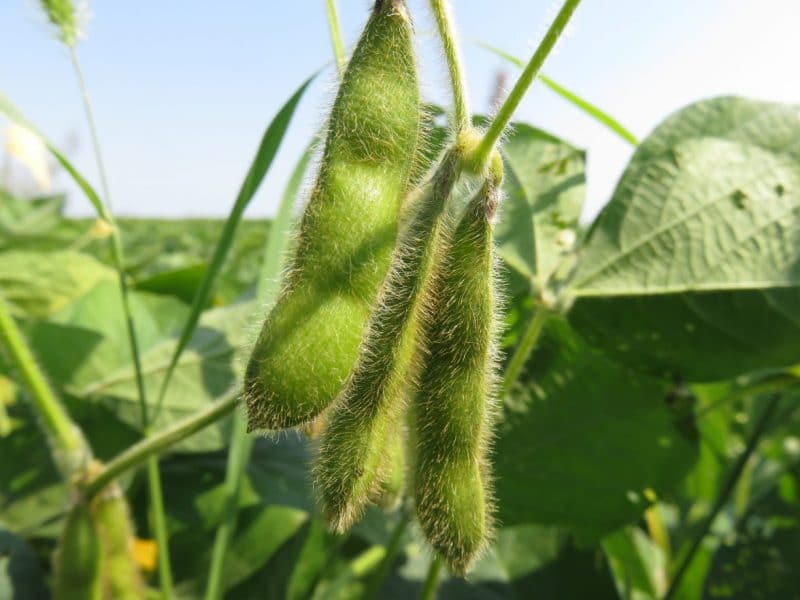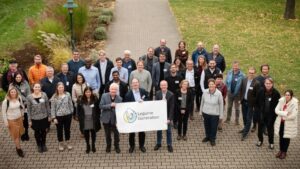Farm animals can’t do without plant proteins. As a source of amino acids for livestock, they are an essential component of animal feed. The EU is raising the ambition on growing more protein crops, although agro-climatic conditions are such that our farmers are more efficient in producing high-yielding energy-rich crops. European Seedsat down with Alexander Döring, Secretary-General of the European Feed Manufacturers’ Federation (FEFAC), to get his take on what needs to change.
European Seed (ES): Alexander, the European Commission will publish its highly anticipated European Protein Plan in November. Why is this plan necessary?
Alexander Döring (AD): The EU has been reliant on imports from non-EU countries to satisfy its needs for protein-rich feed materials to feed its livestock population for a long time, which in public debate is referred to as the so-called “EU protein deficit”. The deficit is covered with imports of mainly soybean products from Brazil, Argentina and the United States. One of the reasons for the European Commission to launch a European Protein Plan is to boost EU vegetable protein production to increase the EU’s resilience of crop production systems, even though we will remain reliant on imports for the foreseeable future. FEFAC fully supports the initiative, as we know that for livestock production, protein will increasingly become the limiting resource on the global agricultural commodity market. At the same time we invite policy makers to take a look at the broader picture. The deficit, and therefore the need for imports, is felt the strongest in protein-rich feed materials. We shouldn’t forget the contribution of a lot of “low” (cereals) and “mid-range” (rape & sunflower) meals as important home-grown protein sources, while cattle rely on grazing & forages as the main source of vegetable proteins. And there are other protein sources of non-vegetable origin, such as insects, processed animal protein & fishmeal for fishfeed, single cell proteins and microbial biomass and yeasts.
[tweetshare tweet=”The European Protein Plan aims to boost EU vegetable protein production to increase the EU’s resilience of crop production systems” username=”EuropeanSeed”]
ES: Concretely, what will the European Commission do? What have they done so far?
AD: They have held a very successful online stakeholder consultation and conducted three thematic workshops with invited groups of experts, the fourth and last one takes place in September 2018. They cover topics such as research and innovation, agronomic challenges and environmental benefits, and market potential in feed and food markets. An independent market research study is scheduled to be released before the end of the summer 2018. The conclusions of the consultations, the market research study and experts’ workshops on the draft European Protein Plan will be presented at a high-level conference on Plant Protein Production in the EU in Vienna on 22 and 23 November 2018. The Commission has highlighted that the European Protein Plan will attempt to provide a blue print of options within the context of the Common Agricultural Policy (CAP) that can inspire Member States to encourage the production of vegetable protein at national level. In that sense, the European Protein Plan will not deliver new legislative actions at EU level, but will refer to the level of ambition by the Member States as laid down in their future CAP national Strategic Plans, which are a key part of the new CAP delivery model. The Commission has thanked FEFAC for its contributions during the drafting process and highlighted that the level of success depends to a great extent whether the European feed industry is able to incorporate the cultivated protein crops and their processed products in their feed formulations to meet nutritional requirements of our farm animals.

ES: In your view, what kind of policy measures are necessary for the EU to be able to produce enough protein plants?
AD: First of all, we call for a more ambitious, broader long-term protein strategy at EU level. This topic should not disappear from the agenda of the European Commission after the European Protein Plan is published. There are different EU policies that affect the production of vegetable proteins in the EU, the most important one being the Renewable Energy Directive (RED). The RED II (2020-2030) continues to incentivise the production of crop-based biofuels by fiscal support measures, from which we get the highly valued rapeseed meals. The ‘strategic protein dimension’ should be felt in the future development of this energy policy. Another financial instrument to boost competitiveness is through the CAP, which allows for coupled support measures at Member State level and may offer more flexibility for shifting support to protein crops. At the same time we do take a more critical view of some Member States who seem to call for a reshape of the current supply and demand balance of protein sources focusing on niche marketing for “non-GM” protein crops. This could jeopardise our call for a more competitive livestock sector, which increasingly relies on exports.
[tweetshare tweet=”FEFAC calls for a more ambitious, broader long-term plant protein strategy at EU level ” username=”EuropeanSeed”]
ES: To arrive at the most resource efficient use of available protein sources it is important that the feed and the seed industry work together on this. How is this cooperation taking place at the moment? Is there room for improvement?
AD: Indeed, there is a lot of room for improvement when it comes to developing the seed and feed research interface. Plant breeding, agronomic and animal nutrition science are constantly evolving and somewhere they must meet. We see a very important role for innovative plant breeding to have an impact on Europe’s capacity to grow the quality of vegetable protein that is useful for compound feed manufacturers, which requires coordination of respective demands and possibilities. We understand that arable farmers have a preference for protein crop varieties with improved yields and better disease resistance, but we see value in linking up with the livestock farmer demands for better protein quality. Amino acid profile, nutrient density, protein concentration, digestibility and palatability are all parameters that influence the decision of the modern animal nutritionist to incorporate a certain protein source in the feed formulation, as is also the presence of anti-nutrients. Suitability of protein sources is of course also determined by the animal species, age and breed. In addition, animal nutrition science increasingly needs to look beyond only animal requirements and take into account the reduction of nutrient leakage into the environment, just to mention non-digestible phosphates in rapeseed meal as one example. Increasingly, we also need to consider the impact of increasing the suitability of vegetable protein to meet livestock needs as a consequence of processing.
[tweetshare tweet=”There is a very important role for innovative plant breeding to have an impact on Europe’s capacity to grow the quality of vegetable protein that is useful for compound feed manufacturers” username=”EuropeanSeed”]
ES: What changes in plant varieties is the feed industry looking for then?
AD: If I can mention an inspirational example, then my thoughts go back to the introduction of 00-rapeseed varieties in the 1980s with reduced levels of erucic acid and glucosinolate, a restrictive anti-nutrient for farm animals. Plant breeding innovation made it possible for rapeseed meal to be used in feed. In combination with improvement in processing technology it is currently the most important EU grown vegetable protein source in compound feed manufacturing, with a growing share also in monogastric feeds. The reduction of alkaloids in sweet lupins allowed for their increased inclusion rates into feed formulation. Tannins were bred out of sorghum about 15 years ago, but they can still be a limiting factor for peas and faba beans.
There are still plenty of anti-nutrients in protein sources that affect the digestibility and often require specific feed processing and treatment to remove them, which is costly. In legume seeds (soybeans, peas and beans) protease inhibitors (e.g. Trypsin) and lectins are the most important anti-nutritional factors. B-conglycinin, Stachyose and Raffinose are other examples of anti-nutrients reducing the nutritional value of soybean products.
ES: Which crops provide the biggest opportunities to achieve the goal of increased vegetable protein production in Europe?
AD: For an increase of European vegetable protein production, increased protein content of already existing protein sources will move us forward the quickest. Higher levels of digestible protein in for example in soy, rapeseed and sunflower will have a bigger impact on the European protein balance sheet than setting aside land for the cultivation of peas or beans. We know that seed breeding is a lengthy R&D process where today’s decision could take 10-15 years to become market reality. Hence our call for a long term strategies setting realistic goals.
ES: Soybean is the main crop that provides the EU livestock sector with protein-rich feed materials. Is there any reason that this would change in the future?
AD: Soybean meal definitely is the highly competitive benchmark for new protein sources trying to make an entry. With its ideal amino-acid profile it scores high on all protein quality parameters. In addition, its affordability, consistency and all-round availability, including the possibility for using price hedging tools, make it the first choice for both animal nutritionists and feed buyers. Only rapeseed meal and sunflower meal have been able to deliver mainstream market solutions, thanks to a combination of fiscal support for biofuels and advances in plant breeding and processing technology. Growing more soybean in Europe is therefore also one of the most likely options to have an impact on boosting the balance sheet of home-grown vegetable protein sources.
[tweetshare tweet=”Growing more soybean in Europe is one of the most likely options to have an impact on boosting the balance sheet of EU-grown vegetable protein sources.” username=”EuropeanSeed”]
ES: The last few years there has been a lot of discussion on plant breeding innovation leading to better plant varieties. What is FEFAC’s position on these new techniques?
AD: For FEFAC there is no doubt that the most modern techniques that innovative plant breeding has to offer are absolutely necessary if Europe wants to be serious about increasing the production of vegetable protein. We recognise the fast growing range of possibilities, even though the R&D trajectory will remain long. The recent ruling of the European Court of Justice in the mutagenesis case however may be game-changer as it could effectively impose a “de-facto” moratorium on many of these new breeding techniques in Europe. For the feed industry it holds the risk that it could also set up a non-tariff trade barrier because of a mismatch in international regulatory approaches on plant breeding innovation. We hope that the European Commission will find a legislative solution, especially now that EU trade discussions with the United States are being relaunched following the joint US-EU statement on trade, signed the same day as the ECJ ruling on Mutagenesis. In any case we will continue to support the European Seed Association in building the scientific & customer benefit argument for Europe to unlock the full potential of modern plant breeding. Knowing that 1stgeneration GMO plants did not provide any direct nutritional benefits for feed formulators, it would be sad for history to repeat itself and force European agriculture as well as the European feed industry to miss out on the promises of modern plant breeding innovation. The EU desperately needs a regulatory framework that supports innovation in the plant breeding sector providing legal certainty for the prospect of cost-efficient investments sustaining the development of a sustainable, competitive animal nutrition sector.
Editors Note: FEFAC: The European Feed Manufacturers’ Federation (FEFAC) was founded in 1959 by five national compound feed associations from France, Belgium, Germany, Italy and the Netherlands. FEFAC membership today consists of 23 national associations from 23 EU Member States as full members and a number of associate and observer members from neighbouring European countries. FEFAC is the only independent spokesman of the European Compound Feed Industry at the level of the European Institutions. FEFAC is member of IFIF, the International Feed Industry Federation and holds observer status in CODEX Alimentarius.













